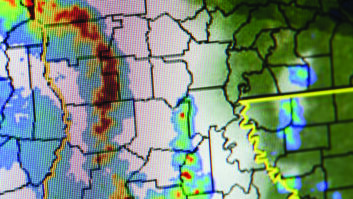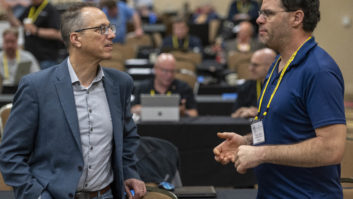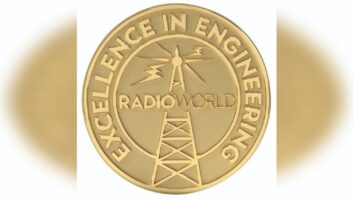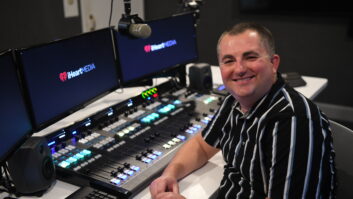Over a period of several years, Actualidad Media Group LLC purchased three AM stations in the Miami area. The three had somewhat overlapping coverage and were on closely spaced frequencies, but their coverage was not ideal.
• WURN 1020 kHz Kendall, Fla. (south of Miami)
• WLVJ 1040 kHz Boynton Beach, Fla. (north of Miami and Ft. Lauderdale)
• WMYM 990 kHz Miami (limited power and highly directional)
Improvement of the service of one or more of these stations was highly desirable. The principal owners of Actualidad have been long-term clients of both Hatfield & Dawson and duTreil, Lundin & Rackley, and so when improvement prospects were considered, they engaged the long-established dTR/H&D Joint Venture (“JV”) of the two firms to examine the possibilities. While the JV normally does work internationally, the firms occasionally collaborate through it on interesting or large-scale domestic projects as well. The project engineers were Ron Rackley and Ben Dawson. Overall project management was by Actualidad President/CEO/Partner Adib Eden and VP of Engineering Jose Zerpa.
The first question asked after the last of the three acquisitions was about the possible improvement of one or more of the station facilities as stand-alone projects. The analysis quickly led to the realization that moving the frequencies of operation of the stations would allow much greater benefits than individual changes or power increases.
This led to consideration of the regulatory restrictions on changes or improvements of AM stations, since any applications would have to propose minor changes, as no AM major change filing window seemed likely. Any possible changes would have to be compatible with the existing AM spectrum in south Florida, which is very congested.
There was significant existing contour overlap of each of the three with other stations, in considerable measure caused by the 1991 first-adjacent channel rule change from 0 to 6 dB. South Florida is very close to Cuba and several other Caribbean countries. Propagation paths to the Atlantic and Gulf coasts of the U.S. are over salt water for considerable distances.
What kind of changes seemed possible under these circumstances? Which frequency would give the best Miami market coverage? Could changes avoid new tower construction or moves of existing towers? Could applications be made that avoided any rule waiver requirements?
ALLOCATION CONSTRAINTS
The most restrictive allocation constraints for the stations were reviewed. Daytime, 990 was limited by 980 Pompano Beach and 990 Orlando. 1020 was limited by 1000 Jupiter and 1020 Grand Turk. 1040 was limited by 1020 Pinellas Park, but daytime power was already 25 kW, with substantial radiation south toward Miami. Nighttime, each of the three had similar incoming nighttime calculated interference levels, although 1020 suffered interference from Cuba.
While calculation of allowable day and night interference (or overlap) conditions to other U.S. stations is straightforward (even if sometimes pretty complex), the circumstances of protection to foreign stations can be very confusing. The ITU Region 2 RJ-81 “Rio” Agreement does not always govern because Cuba is not signatory, the Dominican Republic is not signatory, and several other Caribbean countries are not signatory but “generally” use the RJ-81 standards. The FCC “CDBS” database is sometimes incorrect about foreign stations, with bad data, missing data and multiple entries; the International Telecommunications Union data is the correct legal data when it conflicts with the CDBS.
After extensive analysis, the best improvement plan was determined to be a change of frequencies — a three-station frequency migration: Move 1040 to Miami, move 990 to Kendall, and move 1020 to Boynton Beach. 1040 kHz appeared to be the best choice for Miami. It had the least significant limitations, and the daytime operation was already at high power. Because 1020 and 1040 could not have 5 mV/m overlap, the best location for 1020 was Boynton Beach — further from Miami than Kendall. 990 Kendall was not a limitation on the use of 1040 in Miami, as the two frequencies are 50 kHz separated. But the possible move of frequencies puzzle was: How to change Miami from 990 to 1040 and how to resolve possible 1020 – 1040 conflict?
This required research to obtain all of the measured conductivity reports that might be applicable from the FCC files, and a careful analysis of just which foreign stations required protection, in addition, of course, to meeting all the domestic allocation rules.

Fig. 1: Miami urbanized area

Fig. 2: The Kendall site, typical of the three
A CREATIVE SOLUTION
The commission’s “Rural Radio” rules make many kinds of station changes very difficult. Because 990 kHz and 1040 kHz are not mutually exclusive, changing a station from one to the other would be a major change, prohibited except during a filing window. The last major change window was in 2004, and there was no hope in sight of a new one. The FCC has strict rules against contingent applications as well, with only one very specific exception.
“… the Commission will accept two or more applications filed by existing AM licensees for modification of facilities that are contingent upon granting of both, if granting such contingent applications will reduce interference to one or more AM stations or will otherwise increase the area of interference free service.” (47 CFR §73.3517)
We had to determine how to resolve the “Rural Radio” restrictions, which in essence serve to make station move-ins and other possible station location changes very difficult or even impossible.

Fig. 3: 990 Kendall improvement

Fig. 4: 1020 Boynton Beach improvement

Fig. 5: 1040 Miami improvement
We discovered that all three cities, Miami, Kendall, Boynton Beach, are in the same urbanized area! And the Rural Radio rules do allow changes from one community to another within the same urbanized area. See Fig 1.
So, each station could move — change community of license — without conflicting with the Rural Radio restrictions. And no rule waivers would be required, so long as some interference reduction occurred to meet the contingent application rule!
But what were the physical requirements?
Each of the three stations employed a relatively complex antenna — six tower arrays in Miami and Kendall, and a four-tower array in Boynton Beach. A rigorous analysis of the allocation and coverage requirements was made, and day and night radiation patterns designed for each of the three stations at its “new” location. See Fig 2.
In each case, the new antenna patterns were created with no requirements for additional towers or for tower relocation. See Figs 3–5.
The contingent application rule requires interference reduction, but all the other FCC allocation rule had to be met:
• No increase in overlap to other domestic stations daytime.
• No increase to 25 percent RSS interference to other domestic stations nighttime.
• Although the contingent application rule requires at least one case of interference reduction, in this case interference was reduced to all three.
• FCC policies do not require analysis of interference from Cuban or Dominican Republic stations because they are not signatory to the RJ-81 Agreement.
• But we cannot increase interference to assignments contained in the ITU Master Frequency File, including those in Cuba and the Dominican Republic.
Fig. 6 shows an example of what we came up with.

Fig. 6: Interference reduction example

Fig. 7: Project manager and engineers confer about space limitations at the Miami site.
The applications were prepared and filed, and the construction permit grants were made very promptly, since no rule waivers were required.
The physical changes necessary to implement the construction permits at the three sites varied. At Kendall, only a few components were changed, and the ATUs and phasor readjusted. At Boynton Beach, the ATUs and phasor were replaced, and a new modular transmitter building was installed. At Miami, the existing 5 kW phasor and ATUs were completely rebuilt. A new minimal parts count phasor design allowed 50 kW operation in what had formerly been a 5 kW phasor. See Fig. 7.
The uniqueness of this project really didn’t involve any unusual allocation or facilities engineering. Its unique characteristics were primarily the careful technical and procedural analysis and design to allow the changes with minimal administrative process — no waivers of FCC rules, no tower construction, no local permitting problems. The result: Improved service for all three stations.
Benjamin F. Dawson, P.E., is a senior engineer for Hatfield & Dawson Consulting Engineers, with more than 60 years’ experience in the broadcast and RF engineering field. He has written numerous papers on antenna, propagation and spectrum allocation matters.












